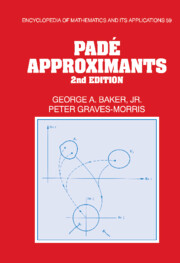Book contents
- Frontmatter
- Contents
- Preface
- Preface to the first edition
- 1 Introduction and definitions
- 2 Elementary developments
- 3 Padé approximants and numerical methods
- 4 Connection with continued fractions
- 5 Stieltjes series and Pólya series
- 6 Convergence theory
- 7 Extensions of Padé approximants
- 8 Multiseries approximants
- 9 Connection with integral equations and quantum mechanics
- 10 Connection with numerical analysis
- 11 Connection with quantum field theory
- Appendix: A FORTRAN FUNCTION
- Bibliography
- Index
Preface to the first edition
Published online by Cambridge University Press: 29 September 2009
- Frontmatter
- Contents
- Preface
- Preface to the first edition
- 1 Introduction and definitions
- 2 Elementary developments
- 3 Padé approximants and numerical methods
- 4 Connection with continued fractions
- 5 Stieltjes series and Pólya series
- 6 Convergence theory
- 7 Extensions of Padé approximants
- 8 Multiseries approximants
- 9 Connection with integral equations and quantum mechanics
- 10 Connection with numerical analysis
- 11 Connection with quantum field theory
- Appendix: A FORTRAN FUNCTION
- Bibliography
- Index
Summary
These two volumes are intended to serve as a basic text on one approach to the problem of assigning a value to a power series. We have attempted to present the basic results and methods in as transparent a form as possible, in line with the general objectives of the Encyclopedia. The general topic of Padé approximants, which is, among other things, a highly practical method of definition and of construction of the value of a power series, seems to have begun independently at least twice. Padé's claim for credit is based on his thesis (1892), in which he developed the approximants and organized them in a table. He paid particular attention to the exponential function. He was presumably unaware of the prior work of Jacobi (1846), who gave the determinantal representation in his paper on the simplification of Cauchy's solution to the problem of rational interpolation. Also, Padé's work was preceded by that of Frobenius (1881), who derived identities between the neighboring rational fractions of Jacobi. It is interesting to note that Anderson seems to have stumbled upon some Padé approximants for the logarithmic function in 1740. A photograph of H. Padé is to be found in The Padé Approximant Method and Its Application to Mechanics, edited by H. Cabannes. A copy of his autographed thesis is to be found in the Cornell University Library.
- Type
- Chapter
- Information
- Padé Approximants , pp. xiii - xivPublisher: Cambridge University PressPrint publication year: 1996



